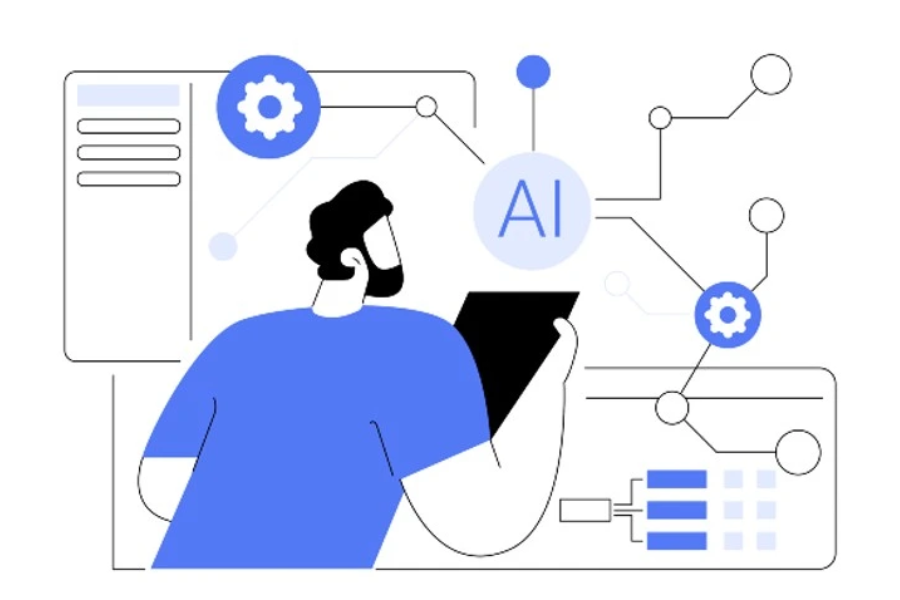Over the years software testing has changed dramatically and automation has become essential to improving accuracy and efficiency. Nevertheless, complex workflows dynamic test environments, and large-scale applications continue to present difficulties for traditional automation frameworks. AI for software testing is transforming the enterprise’s approach to test automation through the introduction of intelligent self-learning capabilities that can adjust to the demands of contemporary software development.
AI-driven testing uses machine learning and predictive analytics to improve test efficiency in contrast to traditional test automation which depends on preset scripts and static validations. AI-powered adaptive test automation improves test coverage and decreases script maintenance by constantly changing with application changes. With the help of AI-powered solutions businesses can automate complex test scenarios identify irregularities instantly and improve test execution with little assistance from humans.
To ensure a more efficient and data-driven testing strategy these clever tools evaluate enormous volumes of test data spot trends anticipate possible failures and rank high-risk areas. This blog examines how artificial intelligence (AI) for software testing is revolutionizing automation by facilitating the smooth execution of intricate workflows reducing manual labor and promoting better application performance.
The Role of AI in Test Automation
Through the integration of natural language processing (NLP) and machine learning (ML) into conventional testing frameworks AI-driven test automation revolutionizes software testing. The intelligent adaptability that testing AI brings allows for dynamic test execution and self-healing mechanisms in contrast to traditional test automation which depends on preset scripts and static validations.
Key Benefits of AI in Software Testing
Quality assurance can be revolutionized with AI-driven testing which improves scalability accuracy and efficiency. Artificial intelligence (AI)-powered test frameworks can handle the complexity of contemporary software development by utilizing automation machine learning and predictive analytics.
The following are some of the main benefits of incorporating AI into software testing:
Self-healing automation for tests
AI-powered self-healing test automation is a revolutionary feature that drastically lowers test automation maintenance requirements. When there are small UI or element changes traditional automated tests frequently fail necessitating manual intervention to update locators or test scripts. This issue is resolved by AI-driven self-healing mechanisms which automatically update test scripts to reflect changes in the applications user interface (UI) and dynamically detect such changes.
Intelligent Test Case Generation
AI-powered intelligent test case generation maximizes test coverage while reducing redundancy by utilizing machine learning algorithms and historical test execution data. Traditional test case creation frequently results in coverage gaps or excessive duplication because it requires manual labor and expertise to identify critical test scenarios. AI-driven solutions overcome these obstacles by automatically creating highly relevant test cases by examining application logs user behavior and defect trends. By doing this test cases are guaranteed to cover high-risk and edge cases while minimizing needless test executions.
Visual Testing with AI
AI-powered visual testing is transforming UI validation by allowing automated identification of visual discrepancies on various screen resolutions, devices, and browsers. In contrast to conventional testing, which focuses mainly on pixel-to-pixel comparisons, AI-driven visual testing tools utilize machine learning algorithms to examine layout structures, identify anomalies, and pinpoint unforeseen visual changes that may affect user experience.
Predictive Test Execution
Predictive test run uses AI-based analytics to intelligently rank and run test cases based on history, code modifications, and possible risk factors. Conventional test run tends to be sequential or in a predetermined sequence, resulting in duplicate test runs and wastage of resources. AI-based predictive testing streamlines this process by examining past test results, detecting frequently failing test cases, and dynamically choosing the most appropriate tests to run.
Automated Defect Detection & Root Cause Analysis
AI-driven defect detection uses machine learning and anomaly detection techniques to find unforeseen failures at an early stage of the software development process. AI-based systems, unlike conventional testing methods that use fixed assertions, scan huge volumes of log data, execution patterns, and system behavior to find anomalies in real-time.
How AI Automates Complex Workflows Effortlessly
AI-driven testing frameworks streamline complex workflows by automating repetitive tasks, intelligently adapting to application changes, and optimizing test execution. Unlike traditional automation, AI integrates self-learning capabilities, reducing manual intervention and improving overall test efficiency.
Test Script Generation Driven by AI:
Writing and updating test scripts by hand can be laborious and prone to mistakes. NLP is used by AI tools like Testim and Mabl to translate plain English instructions into executable test scripts. This method makes it easier for even non-technical testers to create tests.
Implementing Adaptive Testing:
Dynamic web apps with constantly changing user interface elements are often difficult for traditional automation frameworks to handle. Self-learning algorithms are used by AI-powered solutions such as TestCraft and Functionize to adjust to changes in user interfaces guaranteeing consistent test execution without the need for frequent script updates.
CI/CD pipelines with continuous testing:
Through the automation of test selection execution and defect resolution integrating AI-driven testing into DevOps workflows improves continuous testing capabilities. Testing tools driven by AI evaluate code changes in real-time to decide which test cases should be run. This ensures that only pertinent tests are run cutting down on execution time overall. By using sophisticated machine learning models to identify possible failure points based on historical data and system behavior patterns these tools also reduce feedback loops by anticipating defects before deployment.
AI-Powered Performance Evaluation:
By mimicking real-world user behavior and locating bottlenecks before production deployment AI improves performance testing. Tools such as Neotys and LoadNinja examine trends in performance metrics and offer useful insights for optimization.
AI-Powered API Testing
AI-enabled API testing is a feature that boosts the efficacy and trustworthiness of current applications through process automation and minimizing the involvement of humans. Standard API testing needs to be extensive in manual scripting and upkeep so that it remains consistent with evolving APIs, but AI-based tools make it seamless by adapting in real-time to modifications and maximizing test coverage.
Future of AI in Software Testing
The swift development of deep learning robotic process automation (RPA) and cognitive computing will shape testing AI in the future by making software testing more independent intelligent and flexible. With the ability to conduct tests entirely on their own with little assistance from humans AI-powered autonomous testing has the potential to completely transform the industry while lowering test maintenance costs and speeding up development cycles.
The use of AI-generated test cases in which machine learning models dynamically generate highly relevant test scenarios by analyzing user analytics behavioral data and system interactions is another new trend. In addition to improving test coverage, this method guarantees that software is evaluated against actual usage patterns.
Accelerate AI-native testing with LambdaTest.
The cloud-based cross-browser testing tool LambdaTest was developed to improve website responsiveness and speed testing on a variety of devices. With its full suite of test capabilities developers can ensure their websites are appropriately optimized and offer a consistent experience for all users on all devices and browsers. Using an artificial intelligence-based platform for test orchestration and execution LambdaTest enables developers and QA engineers to run automated tests on over 5000+ real environments and 3000+ browser-OS combinations including real-world settings.
Why LambdaTest for AI-Native Testing?
KaneAI by LamdaTest: KaneAI is an AI-Native QA Agent-as-a-Service platform built on modern Large Language Models (LLMs) its world’s first end-to-end software testing agent. It offers a unique approach to planning, authoring, and evolving end-to-end tests using natural language, making software testing more intelligent, autonomous, and efficient.
Scalable Test Execution Driven by AI: Scalability is essential for AI-powered automation and LambdaTests cloud grid offers a fast parallel execution environment that enables teams to run thousands of AI-driven test cases at once. Test cycles are greatly accelerated by LambdaTests support for Selenium Cypress Playwright and other industry-leading frameworks which guarantee smooth test execution across various environments.
AI testing across devices and browsers: It is necessary to validate AI-generated test scripts in real-world settings to guarantee thorough coverage. Teams can carry out thorough cross-browser and cross-device testing thanks to LambdaTest’s access to more than 3000+ browser and OS configurations. Whether testing progressive web applications (PWAs) mobile apps or responsive user interfaces (UIs) LambdaTest guarantees faultless user experiences on a variety of platforms.
Visual regression testing with AI support: Traditional automation may fail to notice visual differences. Teams may eliminate false positives and guarantee pixel-perfect application interfaces by using LambdaTests AI-driven visual testing to automatically identify UI inconsistencies layout changes font mismatches and color variations. This improves the validation of the user experience by identifying even the smallest variations between test runs.
Smart Debugging & AI-Assisted Defect Analysis: Massive volumes of data are produced by AI-powered testing and teams can swiftly spot patterns anomalies and defect trends with the aid of LambdaTests AI-assisted analytics. Developers can track failures improve test execution and address problems more quickly with features like comprehensive logs video recordings and real-time debugging. Teams can anticipate possible points of failure and proactively improve software quality with AI-driven test insights.
Seamless CI/CD Integration for Continuous Testing: Continuous adaptive and smoothly integrated into DevOps pipelines are requirements for AI-powered testing. The plug-and-play integrations that LambdaTest provides with well-known CI/CD tools such as Jenkins GitHub Actions GitLab Azure DevOps and CircleCI allow teams to automate testing at every development stage. LambdaTest makes sure that only the most important test cases are run by minimizing redundancy and optimizing resource usage through intelligent test prioritization and AI-driven test selection.
Conclusion
Software testing is being radically transformed by AI-driven test automation which gives businesses the ability to easily and precisely automate intricate processes. Businesses can speed up software release cycles reduce test maintenance efforts and greatly improve test accuracy by utilizing AI-powered solutions. By enabling teams to move their attention from tedious manual tasks to strategic quality assurance testing AI ensures that applications run reliably across a variety of platforms.
AI-driven testing frameworks are now essential due to the increasing demand for smooth user experiences increased test coverage and quick software deployment. By proactively detecting risks streamlining test execution and guaranteeing ongoing software reliability companies that incorporate AI into their testing strategies obtain a competitive advantage. In an increasingly digital world businesses can improve efficiency future-proof their software quality procedures and propel long-term business success by embracing AI today.
Word Count: 1704



